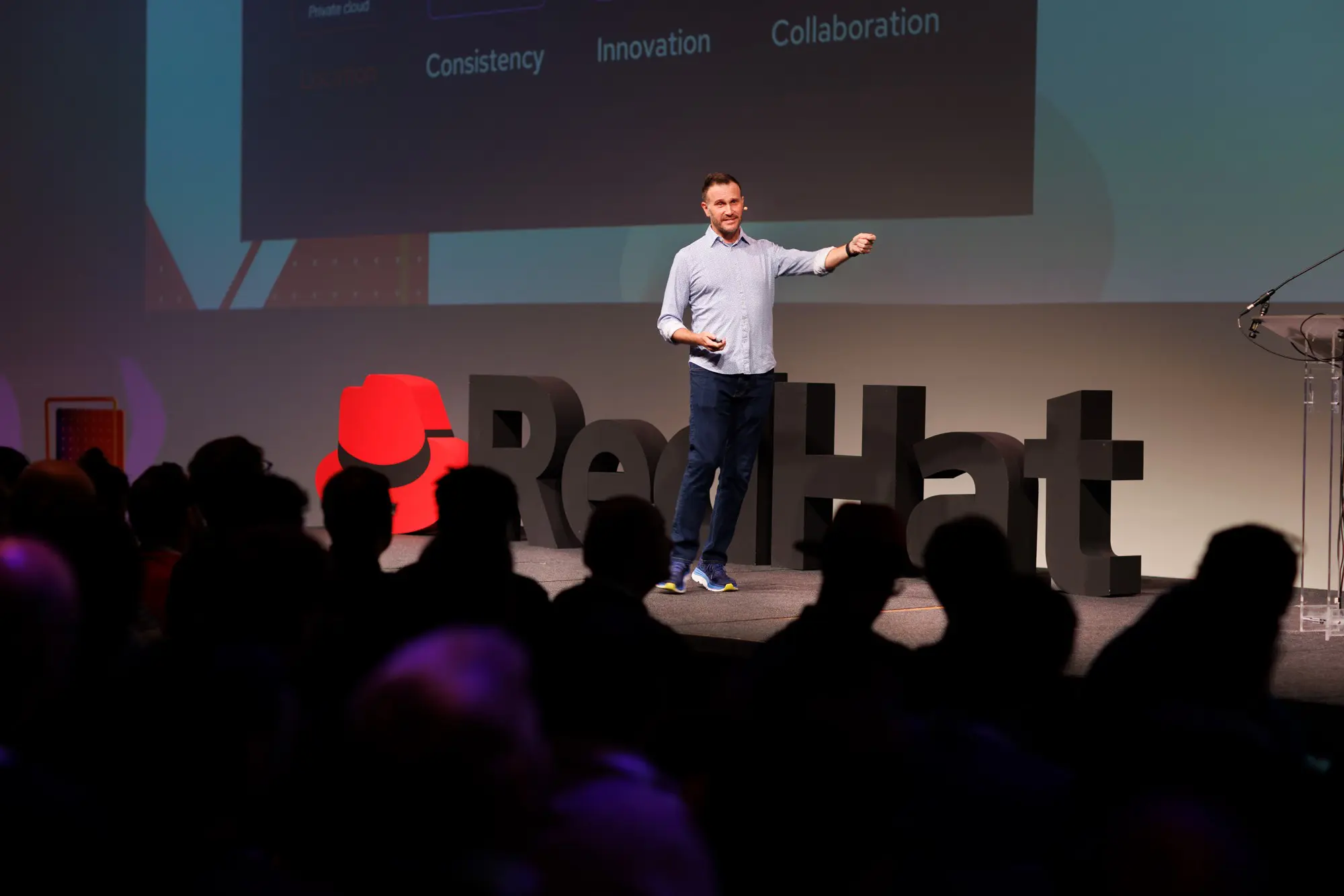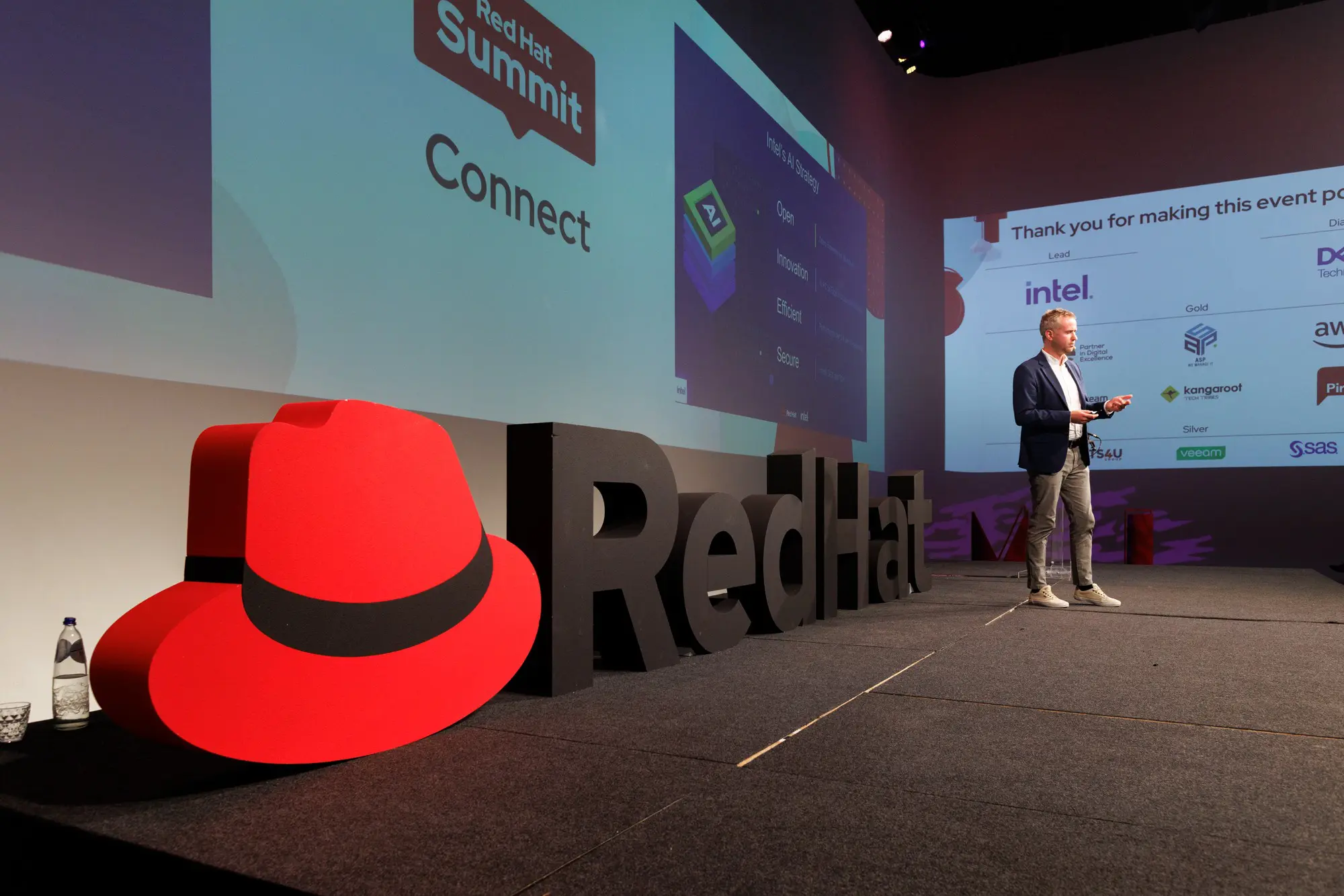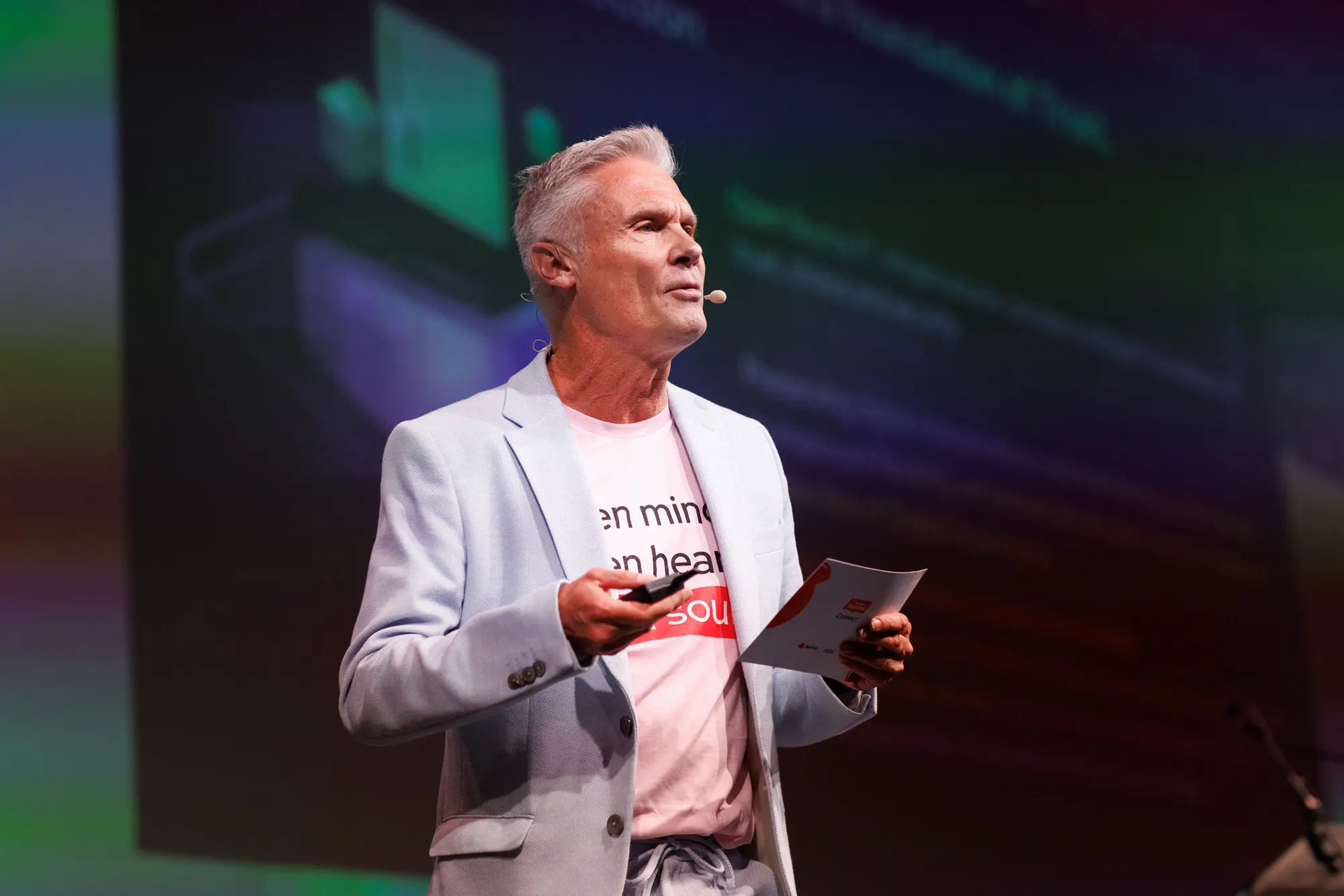At Red Hat Summit: Connect Brussels, Red Hat transformed its well-known open source values — collaboration, transparency, and speed of innovation — into tangible building blocks for the AI era.
The European Red Hat Summit tour kicks off in Brussels. The important thread throughout the event of the red hat: digital sovereignty is not a hurdle, but a driving force for freedom of choice, efficiency, and secure AI acceleration. The company aims to play a central role in this with Red Hat Enterprise Linux 10, OpenShift, and Ansible as strategic pillars.
Stef Schampaert, Country Manager Belux, sets the tone: “The principles of open source are more important than ever. Open source is the foundation of what we do. It fosters collaboration, transparency, and trust.” With this, he explicitly connects digital sovereignty and AI: “Trust is crucial in both digital sovereignty and AI.”

Open Source as a Sovereign Foundation
Alongside Stef, Penny Philpot, VP Ecosystems EMEA, takes the stage. She concretizes everything into five commitments towards customers and partners:
- Open source software
- Open hybrid cloud
- Critical infrastructure
- Local ecosystem of partners
- Sovereign AI workloads.
“Local partners are more important than ever. Without you, the offering is incomplete,” she emphasizes. At the same time, she points to a trend that everyone in the room feels: in the coming years, sustainability and digital sovereignty will become top criteria in choosing public cloud GenAI services.
Open source is the core for collaboration, transparency, and trust. AI is moving fast, and open innovation is the reason it works.
Stef Schampaert, Country Manager Belux at Red Hat
This vision fits perfectly into Red Hat’s positioning of OpenShift and Ansible as the backbone for operations across private, public, and sovereign clouds, including edge footprints.
Chris Morgan, VP Hybrid Platforms Tech Marketing, clearly summarizes the cloud lessons in his keynote: innovation has accelerated, but consistency (operations, security, tooling) determines who scales without friction.
Platform Consistency as an Accelerator
During the keynote, the speakers continuously translate principles into tooling. The core: an open hybrid cloud platform where containers and virtual machines are equal first-class citizens, and where AI workloads land alongside traditional apps.

OpenShift Virtualization brings VMs to the same platform as containers, with a single operating model for logging, metrics, policies, and security. In practice, this is not a theoretical exercise: Morgan outlines migration paths with assessment, proof of value, and even a migration factory approach for scale.
Without our local partners, the system is incomplete. You bring sovereignty and innovation closer to the customer.
Penny Philpot, VP Ecosystems EMEA at Red Hat
An example from Emirates NBD bank illustrates the route: more than 9,000 VMs migrated, 37,000 containers on OpenShift, 140 VMs per night, and 70 percent of the application landscape on RHEL. For the bank, the single-platform model primarily provided certainty and lower operational costs.
OpenShift Virtualization has now become a mature component of OpenShift: it allows organizations to run and manage existing VM workloads alongside container workloads within a single Kubernetes-driven platform.
RHEL 10: Cloud Native OS Management
A second focus is RHEL 10. With image mode, you manage the operating system like application images: immutable OS images with automated updates and rollbacks, quick to build and deploy through the same DevOps/CI-CD pipelines. This limits drift, reduces the attack surface, and accelerates lifecycle management.
Morgan outlines the ‘one definition, multiple formats’ concept: define your image once from a (container)file and publish to container, VMDK, or cloud image. “Pretty powerful, pretty efficient.”

RHEL Lightspeed, an AI assistant on the command line, received a live demo from Ludovic Aelbrecht (App Platform & AppDev Advisor). In a live demo, he quickly creates a user with a secure password and troubleshoots a failing service, all in the terminal for accelerated management. “The idea is really to make you work more efficiently,” he said.
Developer-first Platform
In a next demo, Aelbrecht shows how Red Hat Developer Hub becomes the developer portal where templates (“golden paths”), self-service, and governance come together. From that portal, he provisions a VM on OpenShift Virtualization, with GitOps on the backend and a single console experience for logs and metrics. “When everything runs in the same environment, it’s just much more practical for developers,” he says.
Developer Hub is officially Red Hat’s enterprise-grade IDP based on Backstage, designed to accelerate onboarding and reduce the cognitive load of developers.
Two worlds are now coming together: VMs and containers. It seems simple, but there’s an enormous amount of work behind it to make it so seamless.
Chris Morgan, VP Hybrid Platforms Tech Marketing at Red Hat
Red Hat explicitly links this to the broader Advanced Developer Suite story: a bundle that combines productivity (Developer Hub, Dev Spaces, templates) and software supply chain security (Trusted Artifact Signer, Trusted Profile Analyzer). According to them, it’s exactly what platform engineering teams need to deliver ‘golden paths’.
Additionally, Trusted Software Supply Chain builds automated guardrails throughout the SDLC (systems development life cycle), including signing and SBOM validation (software bill of materials). For organizations wanting to operationalize DevSecOps without losing speed, this is a key piece.
Automation with Ansible
In operations, Red Hat pushes Ansible Automation Platform forward as the standard layer for policy-driven automation, now supplemented with Ansible Lightspeed (AI assistance for platform admins and automation engineers) and Event-Driven Ansible for real-time response scenarios.
The combination of AI assistance, policy-as-code, and event triggers has only one goal: to operate faster, more consistently, and more securely across multi-cloud and edge, without islands per technology. That’s also what Morgan emphasizes: “Automate where you’ve already invested and bring VMs and containers together to avoid duplicate work.”

AI-ready Platform
The keynote also pushes OpenShift AI forward as a lifecycle platform for predictive and generative AI, both self-managed and in managed form. The aim: to develop, train, deploy, and monitor models on a consistent hybrid cloud foundation.
We see ‘Model-as-a-Service with Red Hat AI’ appearing multiple times on the slides. Red Hat’s important pitch: maintain hardware and model choice (CPU/GPU, vLLM/Llama-stack), but enforce operational standardization, from data to inference.
Developer Hub gives developers self-service; the same platform for containers and VMs just makes it more practical.
Ludovic Aelbrecht, App Platform & AppDev Advisor bij Red Hat
Morgan summarizes everything: “Every week I have more virtualization meetings than I ever thought I would in 2025. Customers realize that change pays off when VMs and containers truly coexist.” It aligns with his broader statement that open standards and consistency remove the uncertainties of the AI transition.
5 to Remember
Throughout the morning, we see key points that Red Hat repeatedly emphasizes. These are the five most important ones we register:
- Accelerate modernization without lock-in. By consolidating VMs on OpenShift Virtualization, you avoid duplicate toolchains and teams. You get one policy and observability layer for VMs and containers, benefiting migrations and TCO.
- Make the operating system “cloud-native”. RHEL 10 image mode and RHEL Lightspeed reduce management burden and errors, accelerate deployment, and shorten MTTR because expert knowledge is in your terminal.
- Standardize automation. Ansible Automation Platform with Lightspeed and Event-Driven Ansible helps to uniformly code procedures, security checks, and remediations — also useful in sovereign implementations.
- Build a developer experience that lasts. Developer Hub and Advanced Developer Suite deliver golden paths with built-in software supply chain security (signing, SBOM validation, policy checks) — crucial in sectors with strict requirements (NIS2, CRA, sectoral regulation).
- Operationalize AI. OpenShift AI offers a lifecycle platform that manages both predictive and genAI workloads — on-premises, public, edge or sovereign. Combine it with hardware freedom of choice and the OpenShift management model to make pilots production-ready faster.
Sovereign, but above all Faster
In Brussels, Red Hat positions itself not only as an ‘open’ alternative but as an accelerator. The speakers repeatedly emphasize that they have a consistent platform that combines modernization, automation, and AI, with built-in sovereignty and supply chain security.
For organizations struggling with complex hybrid environments, the goal is clear: less fragmentation, more certainty, faster delivery. Schampaert concludes: “AI is not a separate island, but a function on the same open platform you already rely on today.”
